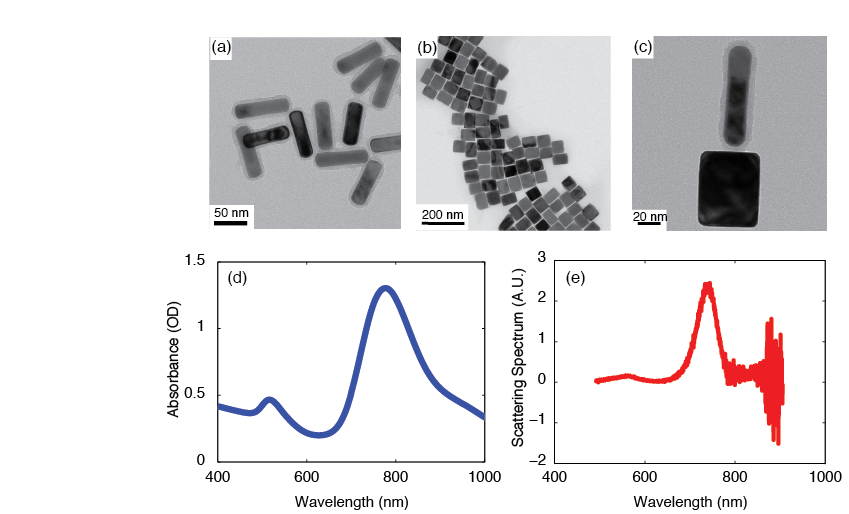Reports: DNI1057029-DNI10: Nanoscale Monitoring of Noble Metal Catalyst Sulfidation Using Plasmonic Nanostructures
Vivian E. Ferry, PhD, University of Minnesota
The objectives of this project are to synthesize nanocrystal heterodimers consisting of a plasmonic nanocrystal and a catalytic nanocrystal, to characterize the optical properties of these heterodimers, and to perform single assembly optical characterization to detect chemical changes in the catalytic nanocrystal via spectral shifts in the plasmonic nanocrystal. This work will be complemented by electromagnetic simulations. In this initial year of the project we have made progress on several of these objectives.
1. Synthesis of plasmonic nanocrystal - catalytic nanocrystal heterodimers via self-assembly
First, we have synthesized the different building blocks for the heterodimers: core-shell Au@SiO2 plasmonic nanorods of varying aspect ratios, core-shell Au@SiO2 plasmonic nanospheres, and Pd nanocubes of varying diameters. To make these plasmonic nanocrystals, we developed a controlled synthesis to reduce the thickness of the SiO2 layer. This layer must be present to avoid diffusion between the metals but also must be thin enough for the plasmonic nanocrystal to detect changes in the refractive index of the Pd nanocube. Finally, we have controlled the ligands on the surface of the Au@SiO2 nanocrystals and the Pd nanocubes to enable electrostatic self-assembly, and tuned the relative concentrations to favor the formation of heterodimers.
2. Optical characterization of plasmonic nanocrystal - catalytic nanocrystal assemblies
Single particle measurements reveal optical properties that are obscured in ensemble measurements.
Figure 1. Synthesis and characterization of heterodimers. (a) Au nanorods capped with approximately 5 nm of SiO2 (b) Pd nanocubes (c) Assembled Au nanorods and Pd nanocubes via electrostatic self-assembly. (d) Ensemble UV-Vis spectra of Au nanorods (e) Single particle dark field spectra on individual Au nanorods.
We have performed ensemble UV-Vis measurements in addition to single particle dark field spectroscopy experiments. We have recently modified both the substrate configuration and the objective in our single particle characterization setup, leading to significantly enhanced signal-to-noise ratios when measuring single assembly data. This optical data is correlated with the structure using either transmission electron microscopy or scanning electron microscopy after the optical measurements are performed.
3. Optical modeling of plasmonic nanocrystal - catalytic nanocrystal heterodimers
To aid in the design of our assemblies, we have also completed an electromagnetic simulation study on these heterodimers. We found that the plasmonic nanocrystal will be more sensitive to changes in the refractive index of the Pd nanocube if the plasmonic particle's resonance is tuned to the near infrared. In this spectral region the refractive index contrast between palladium and palladium hydride or palladium sulfide is the highest. The resonant wavelength can be tuned by changing the shell thickness and diameters. However, this also changes the scattering cross section of the plasmonic nanoparticle. To study these effects in detail, we designed plasmonic nanoparticles with different resonant wavelengths but equivalent scattering cross sections, and then studied the optical properties of their assemblies with Pd nanocubes.
A second simulation study was performed on a plasmonic nanostructure consisting of a hollow Au-Ag alloy nanocube. These structures have tunable resonances (based on the wall thickness and composition) into the near-infrared where we expect to have greater sensitivity to the refractive index changes of Pd. The nanocubes have shells as thin as 1 - 2 nm. We created an optical model for these structures and systematically varied the alloy composition, the diameter and wall thicknesses, as well as the curvature of the corners of the cube, to identify the structures that are most promising to act as sensors of the local refractive index.
Figure 2. Electromagnetic simulations of designer plasmonic nanostructures. (a) Two plasmonic nanocrystals were designed to have the same scattering cross section but at different wavelengths, to determine the relative contributions of the spectral position and magnitude on the sensitivity of the sensor. (b) Simulations also studied the formation of hollow cuboidal structures, with an inner core material of water and 2 nm thick Au-Ag alloys forming the shell. These calculations show a 50% - 50% alloy of Au and Ag. The variable d refers to the diameter of the structure, and calculations are shown for different curvature at the corners of the structure. As the nanoparticle becomes more of a cube, the resonance red shifts to wavelengths that are more sensitive to detecting chemical changes in the Pd nanocube.
Goals for the next reporting period
The goals for the next reporting period are as follows: 1) Continue to measure single particle dark field optical spectra on assemblies made with both Au nanorods and Au nanospheres, 2) Develop improved dark field spectroscopic methods for faster imaging of single assemblies, 3) Use this spectroscopic method to dynamically detect chemical changes in the Pd nanocubes under different gas flow rates, and 4) Use electromagnetic modeling to connect experimental measurements to predicted models.
Educational impact
Funding from this project has primarily supported students. Two graduate students and one undergraduate student have been involved in this project. The students involved in this project are trained in synthesis, self-assembly, structural and optical characterization, and simulation and modeling. One student recently completed his masters thesis on this project.













